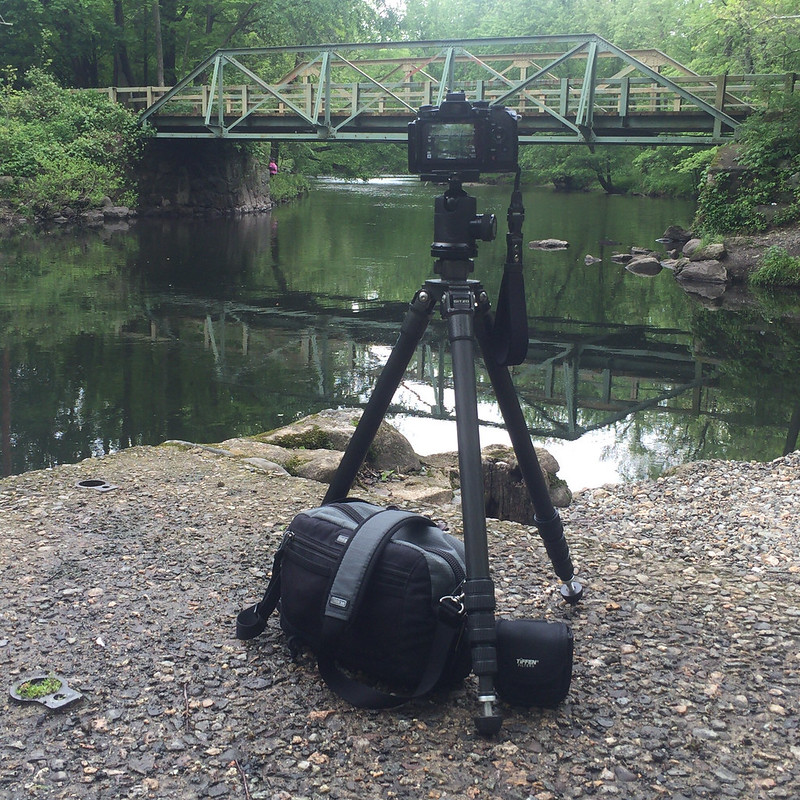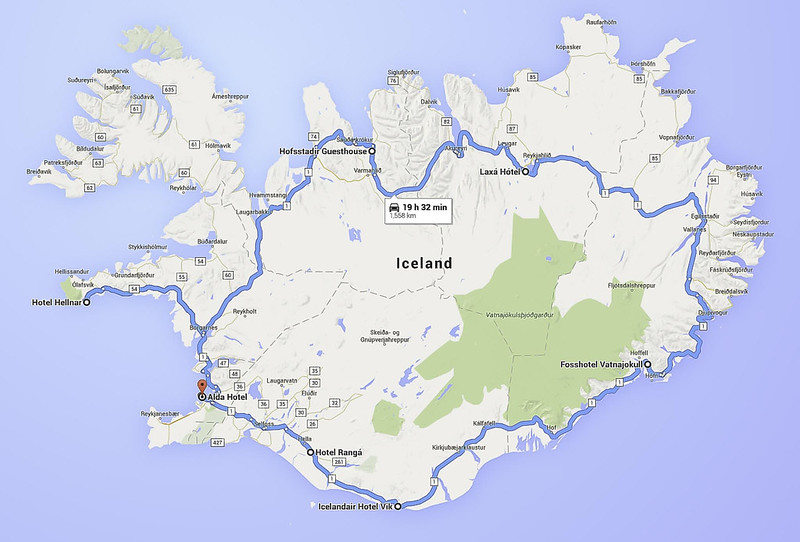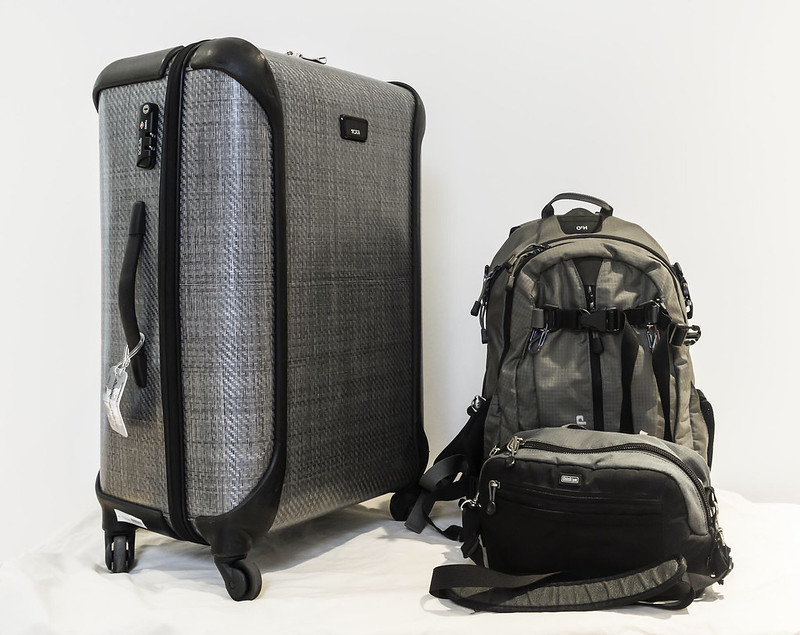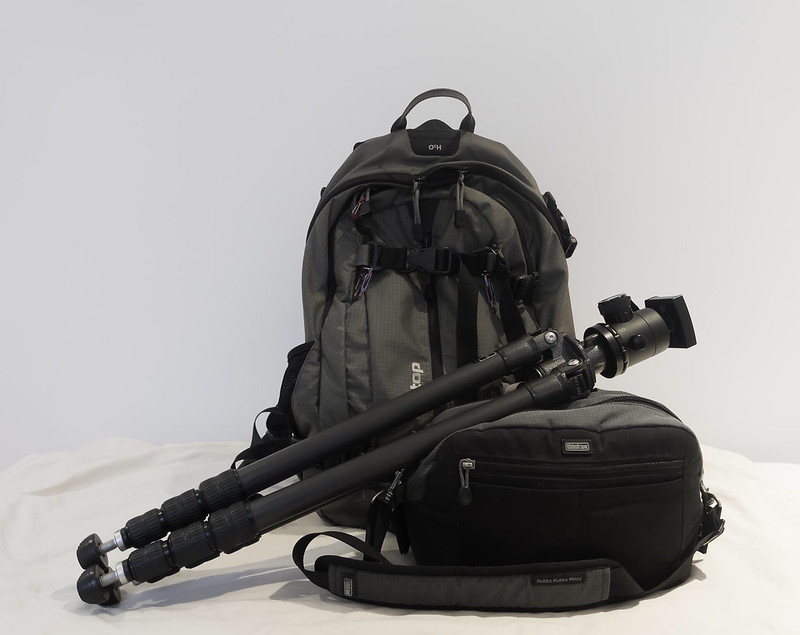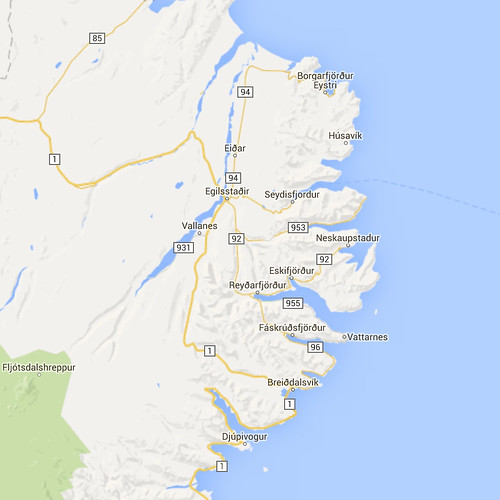 |
| Polaroid Land Camera 800, May 2013 |
Well, I'm finally at a point were I don't need
(1) to buy any new gear for this trip. The Olympus/Panasonic cameras and lenses I've been collecting for the last three years seem to be pretty stable. But, just as with the clothing, I'm going to review the inventory in light of the type of pictures I expect to take
(2). I am primarily going to be taking landscape images, with a bit of cityscape and the usual documentation of our lodging and other interesting things.
So we start with my big tripod
(3). You can't take great pictures if you're holding your camera around in your shaky hands, especially as the sky will be overcast much of the time. And all the waterfalls and shorelines beg for long exposures to give that silky moving-water effect. The tripod and the ball head which goes on it are pretty expensive; together they cost more than either camera. Yet carrying it on-board the plane it is not practical, as there's a real chance the TSA will decide it's a weapon. So it gets disassembled and packed in my checked bag. In a way, that's good; it weighs about as much as my cameras and lenses in total. But loosing it will put a real cramp on my photography on this trip, and I doubt I could buy a new one in Iceland at a reasonable price.
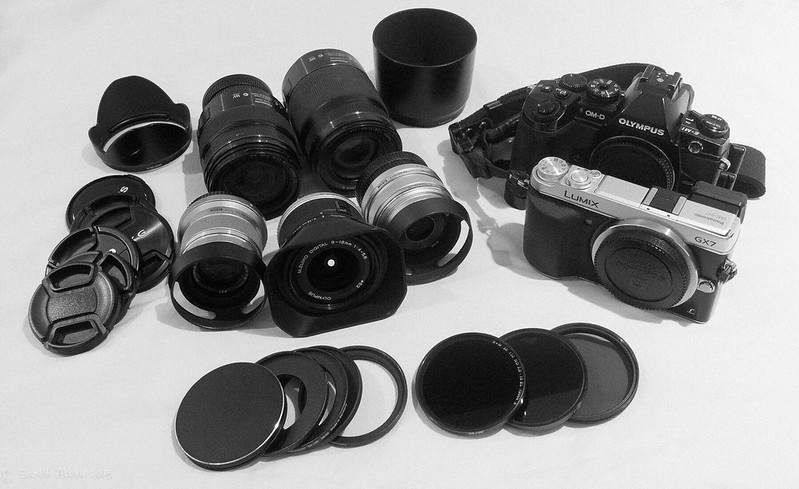 |
| Current camera kit, May 2016 |
On top of the tripod goes one of the cameras, usually the Olympus OM-D E-M1, which is setup for convenient tripod use. The Panasonic Lumix GX7 is a little less convenient in that mode, and is really along as a backup in case the Olympus decides to kick the bucket. Since they use the same lenses, it's a good backup. The Panasonic is also lighter and a bit smaller to carry if we're out for dinner.
A big part of landscape photography is the filters you put in front of the lens to shape and control the light coming in. With digital cameras, the filter requirements are actually far less than they were with film, as many of the adjustments can be made after the fact with software. But not all. There are three types of filters I use:
- a circular polariser (CP) cuts down on glare and reflections, just like your polarised sunglasses. This is particularly useful to make skies blue-er, and make the clouds "pop".
- a neutral density (ND) filter cuts the amount of light entering the camera, enabling you to keep the shutter open longer. This is how you get the silky moving water effect, and we're going to see many waterfalls on this trip.
- a graduated neutral density (GND) filter lets more light in on one half of the scene then the other. This is usually used when the sky is very bright, but the foreground is much darker, perhaps in shadow. It lets the camera record the details that your eye and brain automatically adjust for.
Unfortunately, the GND kit is pretty bulky. With modern digital cameras and sophisticated software like Photoshop, GNDs are not as widely used as they used to be. In some sense, the software - used well - creates better results than the GND filters. I'm leaning towards not bringing them (and they're not shown in the picture above).
The lenses are my standard kit of three zooms
(4) - wide (9-18mm), mid-range (12-35mm) and telephoto (35-100mm) - plus one or two tiny fixed length lenses.
Sadly the two cameras use different batteries, which means different chargers. And since the cameras become paperweights without batteries, at least one backup charger.
Extra memory cards. Straps. A little device to backup the memory cards each day. Stuff to clean the lenses and filters.
It all adds up at the end. And most of it needs to be hand-carried on the plane, either because it's critical, fragile or thief-bait. For instance, I need to carry chargers, as the cameras become useless if they are lost. Of course, the cameras and lenses get carried. The batteries
must be carried per the TSA, because of the lithium fire hazard. The filters, cleaning kit, and straps can be in the checked luggage, along with the tripod. I have a large multi-battery charger which can be checked, and the small slow chargers will be carried.
 |
| Zeiss Ikon Pocket camera, May 2013 |
When we went out West in 2012, the carry-on camera stuff filled a 24" roll-aboard (which is now too big to carry-on), plus some spill-over in my backpack and suitcase. The newer, more compact gear will fit in my backpack along with other carry-on necessities like meds, iPad, a USB charger for the iDevices, etc., with a very small "personal" bag in addition. The kit in the picture above weighs under 5 lbs. The tripod adds another 4 lbs. Batteries and other small accessories add (maybe) another pound. So the carry-around weight is about 10 lbs. if I bring everything, plus the bag to carry it all in. Experience tells me it's about 4 lbs. of gear and the 4 lb. tripod most of the time. Not bad at all.
----------------------
(1) "Need" is such an ill-defined word, don't you think?
(2) After all, I am a geek, eh?
(3) It's actually modestly sized by photography enthusiast standards, but my gear is also smaller than the traditional Nikon/Canon stuff most use (and I used to use). It's the biggest tripod I've ever owned. It's also made of expensive carbon fiber, like golf clubs or bicycles.
(4) if you're used to the lenses that we all used to use on 35mm film, double these focal lengths to get the equivalent. If you have a compact camera, it will usually specify the lens focal length as the same "equivalent" sizes.

